Challenges and Strategies for Sustainable Energy Policies and SDGs
VerifiedAdded on 2022/08/22
|10
|3428
|21
Report
AI Summary
This report provides a comprehensive analysis of sustainable energy policies, focusing on the challenges and opportunities in achieving energy-related Sustainable Development Goals (SDGs). It examines the failures of current government policies and their impact on businesses, highlighting the need for innovation in renewable energy and energy efficiency. The report explores strategies for sustainable energy development, including the role of businesses in aligning actions with SDGs and the importance of creating a sustainable future through collaborative efforts. It also discusses the barriers to sustainable energy adoption, such as efficiency and cost, and recommends policies and measures to promote climate change mitigation, emissions reduction, and clean energy. The report emphasizes the need for strategic alignment, value creation, and innovation in businesses to drive sustainable energy adoption, providing insights into the role of corporate strategy, market expansion, and the challenges faced by businesses in pursuing sustainable energy agendas. It highlights the economic benefits of renewable energy projects and the importance of addressing energy access, environmental impacts, and investment maximization. The report also examines the challenges in transitioning to low-carbon energy, the failures in government policies, and the need for transparency, accountability, and inclusivity in achieving sustainable energy goals. Finally, it discusses the role of policy innovations, finance, and infrastructure in creating a clean, reliable, and resilient energy future.
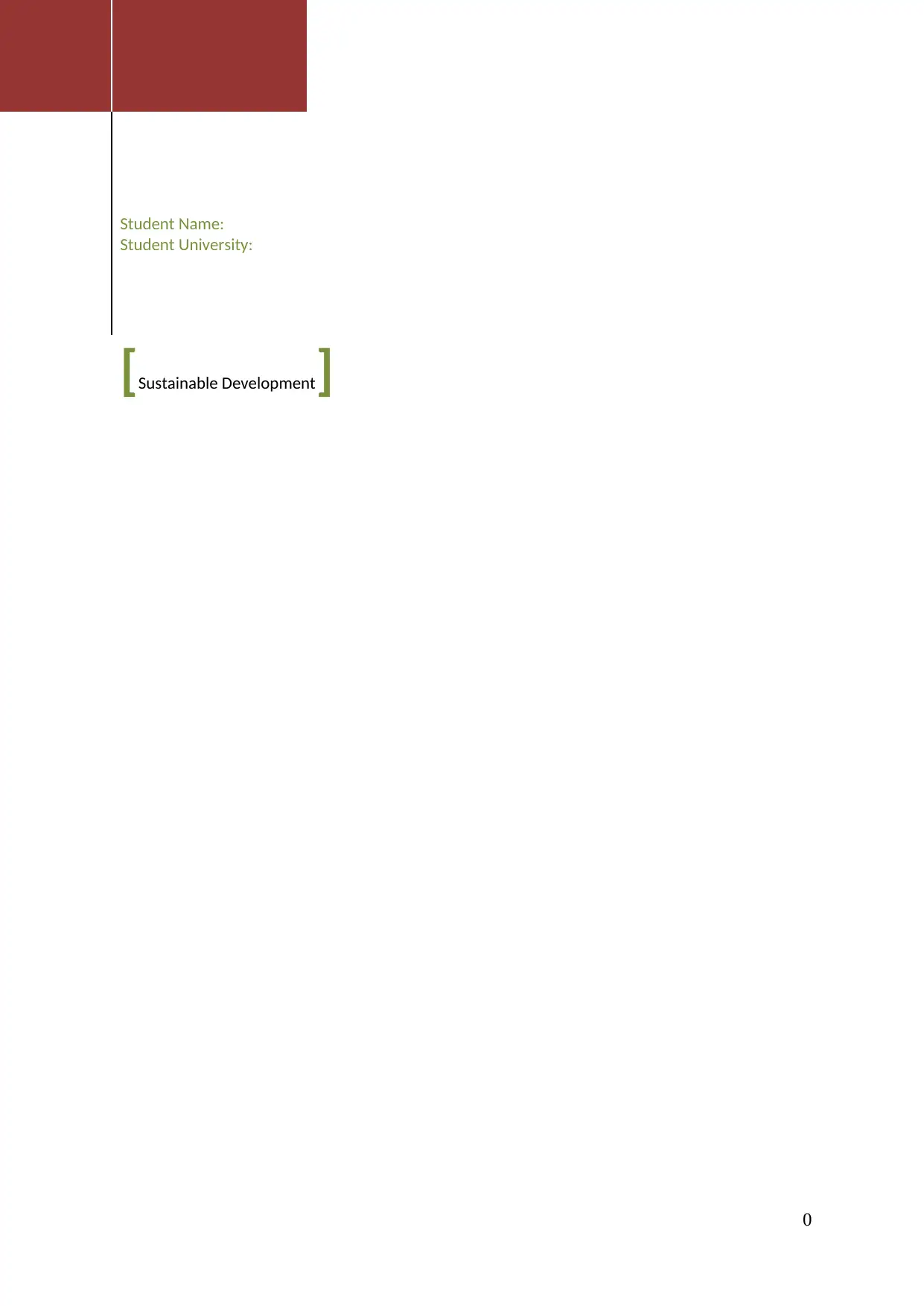
[Sustainable Development]
0
Student Name:
Student University:
0
Student Name:
Student University:
Paraphrase This Document
Need a fresh take? Get an instant paraphrase of this document with our AI Paraphraser
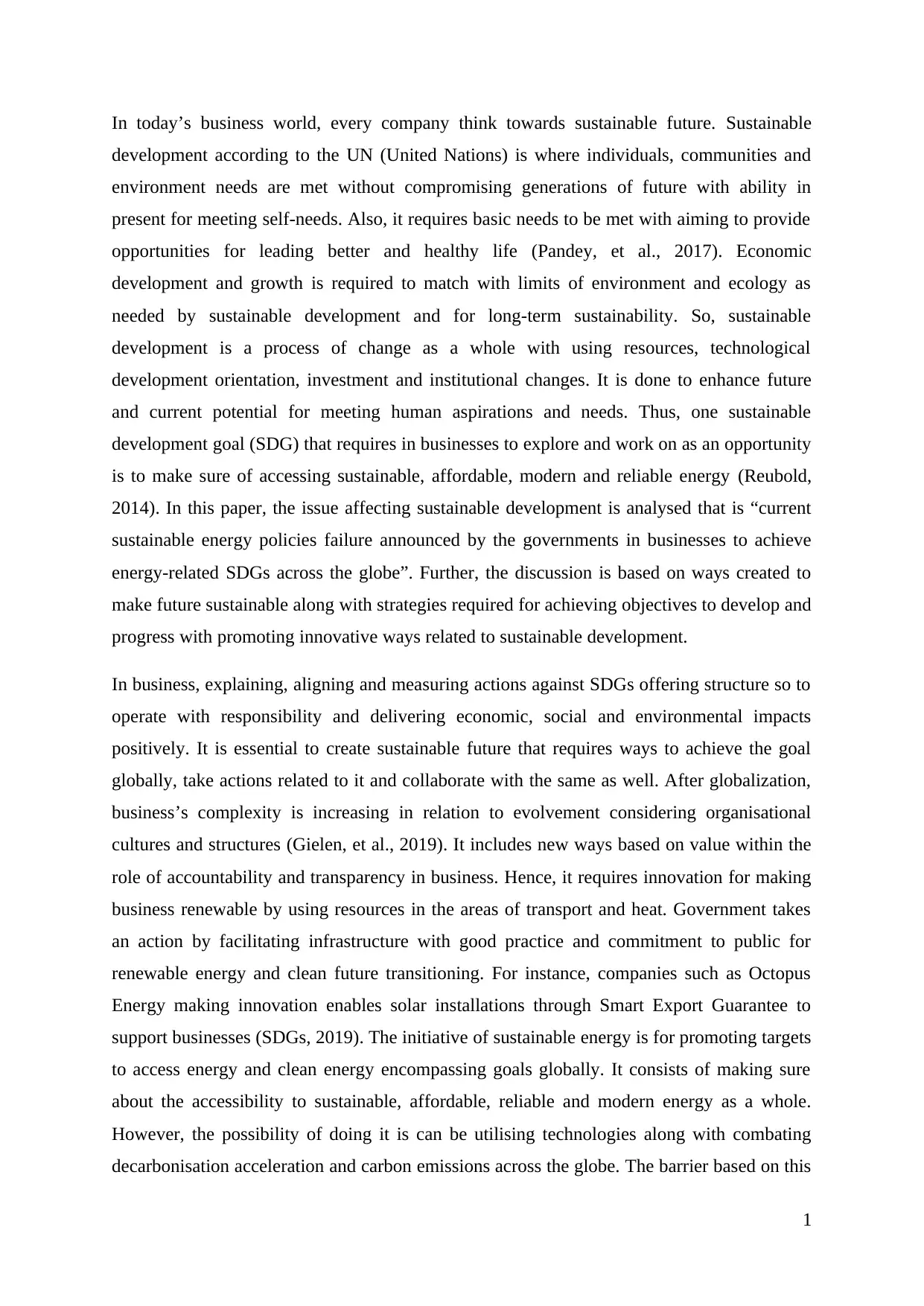
In today’s business world, every company think towards sustainable future. Sustainable
development according to the UN (United Nations) is where individuals, communities and
environment needs are met without compromising generations of future with ability in
present for meeting self-needs. Also, it requires basic needs to be met with aiming to provide
opportunities for leading better and healthy life (Pandey, et al., 2017). Economic
development and growth is required to match with limits of environment and ecology as
needed by sustainable development and for long-term sustainability. So, sustainable
development is a process of change as a whole with using resources, technological
development orientation, investment and institutional changes. It is done to enhance future
and current potential for meeting human aspirations and needs. Thus, one sustainable
development goal (SDG) that requires in businesses to explore and work on as an opportunity
is to make sure of accessing sustainable, affordable, modern and reliable energy (Reubold,
2014). In this paper, the issue affecting sustainable development is analysed that is “current
sustainable energy policies failure announced by the governments in businesses to achieve
energy-related SDGs across the globe”. Further, the discussion is based on ways created to
make future sustainable along with strategies required for achieving objectives to develop and
progress with promoting innovative ways related to sustainable development.
In business, explaining, aligning and measuring actions against SDGs offering structure so to
operate with responsibility and delivering economic, social and environmental impacts
positively. It is essential to create sustainable future that requires ways to achieve the goal
globally, take actions related to it and collaborate with the same as well. After globalization,
business’s complexity is increasing in relation to evolvement considering organisational
cultures and structures (Gielen, et al., 2019). It includes new ways based on value within the
role of accountability and transparency in business. Hence, it requires innovation for making
business renewable by using resources in the areas of transport and heat. Government takes
an action by facilitating infrastructure with good practice and commitment to public for
renewable energy and clean future transitioning. For instance, companies such as Octopus
Energy making innovation enables solar installations through Smart Export Guarantee to
support businesses (SDGs, 2019). The initiative of sustainable energy is for promoting targets
to access energy and clean energy encompassing goals globally. It consists of making sure
about the accessibility to sustainable, affordable, reliable and modern energy as a whole.
However, the possibility of doing it is can be utilising technologies along with combating
decarbonisation acceleration and carbon emissions across the globe. The barrier based on this
1
development according to the UN (United Nations) is where individuals, communities and
environment needs are met without compromising generations of future with ability in
present for meeting self-needs. Also, it requires basic needs to be met with aiming to provide
opportunities for leading better and healthy life (Pandey, et al., 2017). Economic
development and growth is required to match with limits of environment and ecology as
needed by sustainable development and for long-term sustainability. So, sustainable
development is a process of change as a whole with using resources, technological
development orientation, investment and institutional changes. It is done to enhance future
and current potential for meeting human aspirations and needs. Thus, one sustainable
development goal (SDG) that requires in businesses to explore and work on as an opportunity
is to make sure of accessing sustainable, affordable, modern and reliable energy (Reubold,
2014). In this paper, the issue affecting sustainable development is analysed that is “current
sustainable energy policies failure announced by the governments in businesses to achieve
energy-related SDGs across the globe”. Further, the discussion is based on ways created to
make future sustainable along with strategies required for achieving objectives to develop and
progress with promoting innovative ways related to sustainable development.
In business, explaining, aligning and measuring actions against SDGs offering structure so to
operate with responsibility and delivering economic, social and environmental impacts
positively. It is essential to create sustainable future that requires ways to achieve the goal
globally, take actions related to it and collaborate with the same as well. After globalization,
business’s complexity is increasing in relation to evolvement considering organisational
cultures and structures (Gielen, et al., 2019). It includes new ways based on value within the
role of accountability and transparency in business. Hence, it requires innovation for making
business renewable by using resources in the areas of transport and heat. Government takes
an action by facilitating infrastructure with good practice and commitment to public for
renewable energy and clean future transitioning. For instance, companies such as Octopus
Energy making innovation enables solar installations through Smart Export Guarantee to
support businesses (SDGs, 2019). The initiative of sustainable energy is for promoting targets
to access energy and clean energy encompassing goals globally. It consists of making sure
about the accessibility to sustainable, affordable, reliable and modern energy as a whole.
However, the possibility of doing it is can be utilising technologies along with combating
decarbonisation acceleration and carbon emissions across the globe. The barrier based on this
1
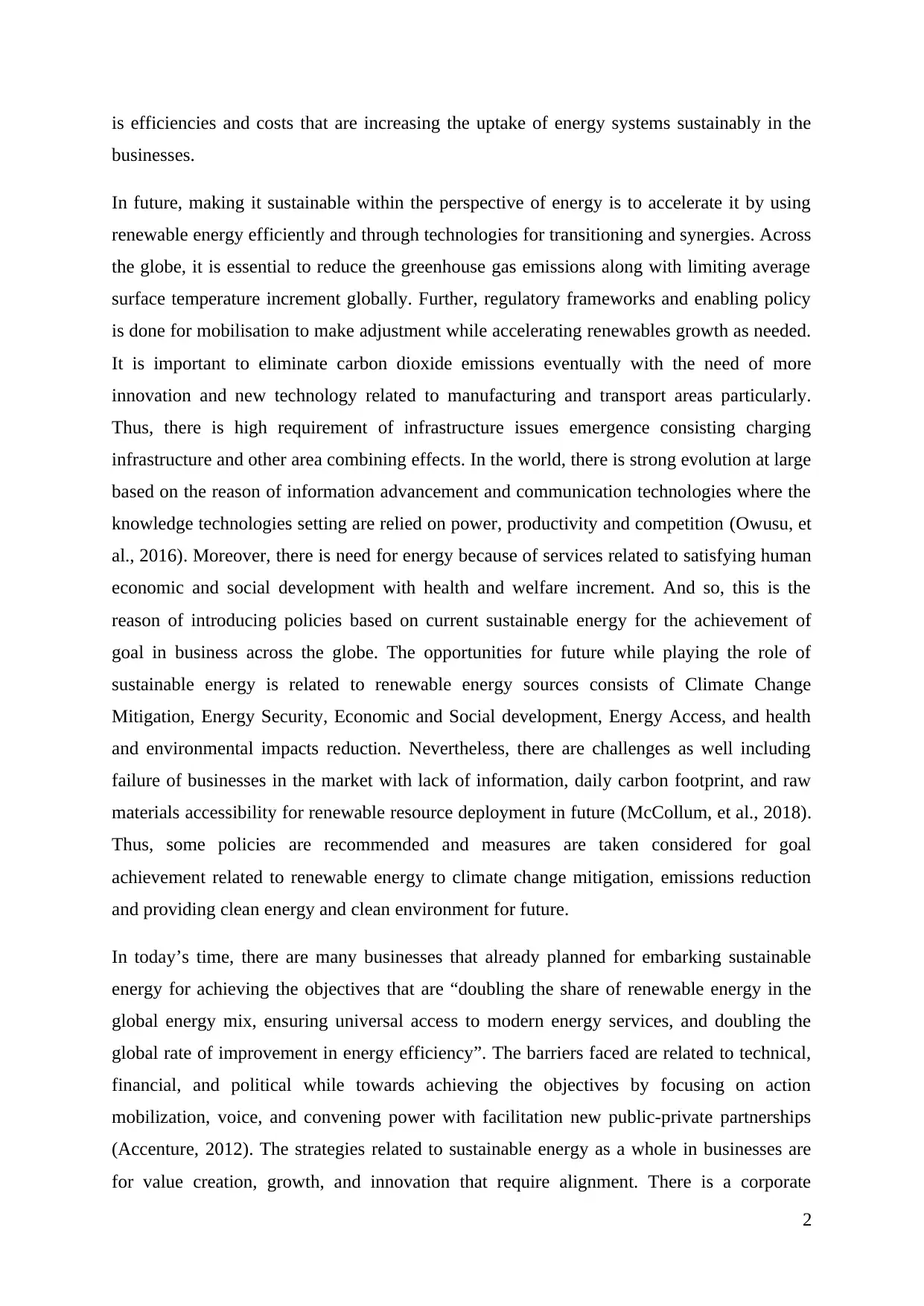
is efficiencies and costs that are increasing the uptake of energy systems sustainably in the
businesses.
In future, making it sustainable within the perspective of energy is to accelerate it by using
renewable energy efficiently and through technologies for transitioning and synergies. Across
the globe, it is essential to reduce the greenhouse gas emissions along with limiting average
surface temperature increment globally. Further, regulatory frameworks and enabling policy
is done for mobilisation to make adjustment while accelerating renewables growth as needed.
It is important to eliminate carbon dioxide emissions eventually with the need of more
innovation and new technology related to manufacturing and transport areas particularly.
Thus, there is high requirement of infrastructure issues emergence consisting charging
infrastructure and other area combining effects. In the world, there is strong evolution at large
based on the reason of information advancement and communication technologies where the
knowledge technologies setting are relied on power, productivity and competition (Owusu, et
al., 2016). Moreover, there is need for energy because of services related to satisfying human
economic and social development with health and welfare increment. And so, this is the
reason of introducing policies based on current sustainable energy for the achievement of
goal in business across the globe. The opportunities for future while playing the role of
sustainable energy is related to renewable energy sources consists of Climate Change
Mitigation, Energy Security, Economic and Social development, Energy Access, and health
and environmental impacts reduction. Nevertheless, there are challenges as well including
failure of businesses in the market with lack of information, daily carbon footprint, and raw
materials accessibility for renewable resource deployment in future (McCollum, et al., 2018).
Thus, some policies are recommended and measures are taken considered for goal
achievement related to renewable energy to climate change mitigation, emissions reduction
and providing clean energy and clean environment for future.
In today’s time, there are many businesses that already planned for embarking sustainable
energy for achieving the objectives that are “doubling the share of renewable energy in the
global energy mix, ensuring universal access to modern energy services, and doubling the
global rate of improvement in energy efficiency”. The barriers faced are related to technical,
financial, and political while towards achieving the objectives by focusing on action
mobilization, voice, and convening power with facilitation new public-private partnerships
(Accenture, 2012). The strategies related to sustainable energy as a whole in businesses are
for value creation, growth, and innovation that require alignment. There is a corporate
2
businesses.
In future, making it sustainable within the perspective of energy is to accelerate it by using
renewable energy efficiently and through technologies for transitioning and synergies. Across
the globe, it is essential to reduce the greenhouse gas emissions along with limiting average
surface temperature increment globally. Further, regulatory frameworks and enabling policy
is done for mobilisation to make adjustment while accelerating renewables growth as needed.
It is important to eliminate carbon dioxide emissions eventually with the need of more
innovation and new technology related to manufacturing and transport areas particularly.
Thus, there is high requirement of infrastructure issues emergence consisting charging
infrastructure and other area combining effects. In the world, there is strong evolution at large
based on the reason of information advancement and communication technologies where the
knowledge technologies setting are relied on power, productivity and competition (Owusu, et
al., 2016). Moreover, there is need for energy because of services related to satisfying human
economic and social development with health and welfare increment. And so, this is the
reason of introducing policies based on current sustainable energy for the achievement of
goal in business across the globe. The opportunities for future while playing the role of
sustainable energy is related to renewable energy sources consists of Climate Change
Mitigation, Energy Security, Economic and Social development, Energy Access, and health
and environmental impacts reduction. Nevertheless, there are challenges as well including
failure of businesses in the market with lack of information, daily carbon footprint, and raw
materials accessibility for renewable resource deployment in future (McCollum, et al., 2018).
Thus, some policies are recommended and measures are taken considered for goal
achievement related to renewable energy to climate change mitigation, emissions reduction
and providing clean energy and clean environment for future.
In today’s time, there are many businesses that already planned for embarking sustainable
energy for achieving the objectives that are “doubling the share of renewable energy in the
global energy mix, ensuring universal access to modern energy services, and doubling the
global rate of improvement in energy efficiency”. The barriers faced are related to technical,
financial, and political while towards achieving the objectives by focusing on action
mobilization, voice, and convening power with facilitation new public-private partnerships
(Accenture, 2012). The strategies related to sustainable energy as a whole in businesses are
for value creation, growth, and innovation that require alignment. There is a corporate
2
⊘ This is a preview!⊘
Do you want full access?
Subscribe today to unlock all pages.

Trusted by 1+ million students worldwide
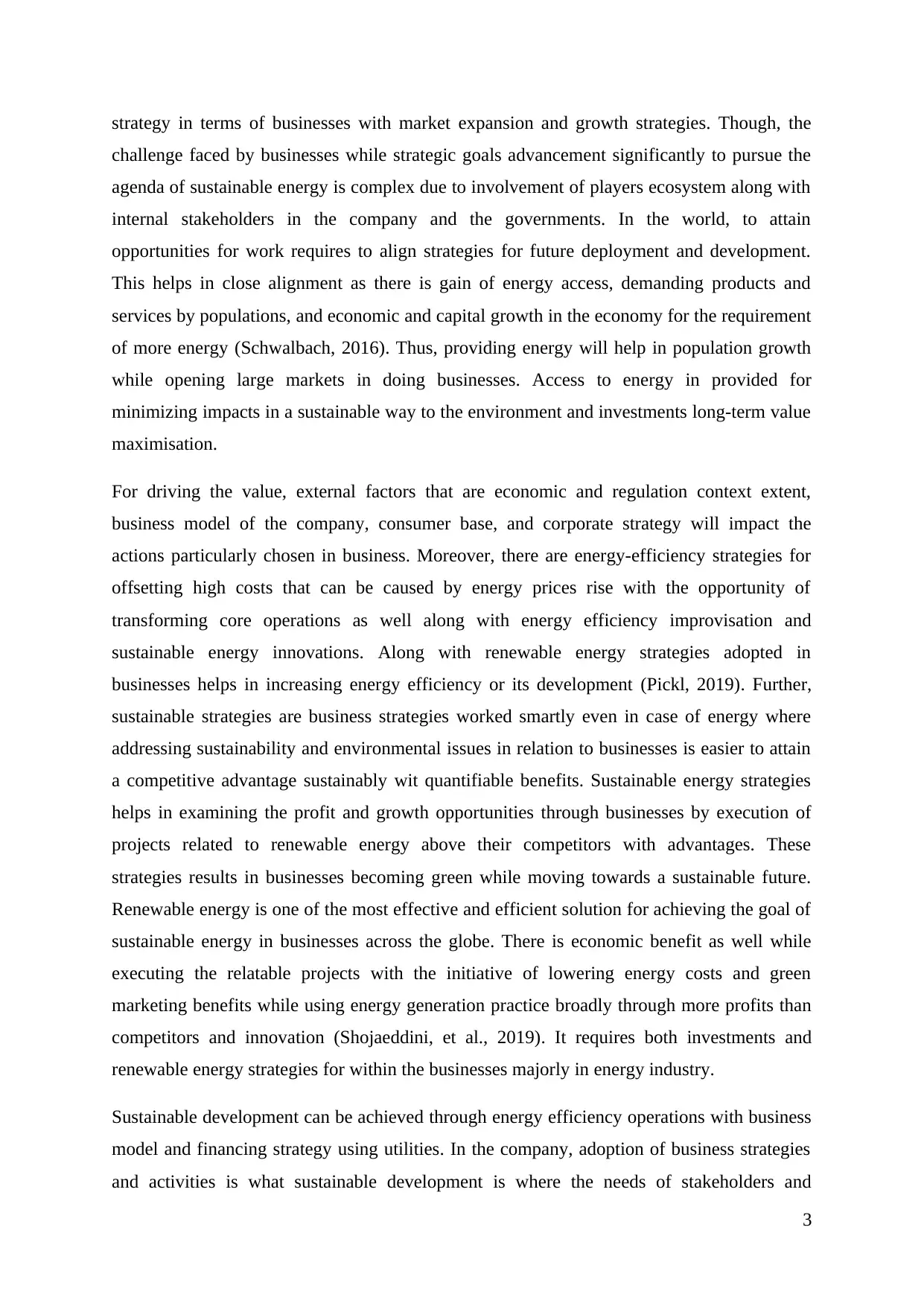
strategy in terms of businesses with market expansion and growth strategies. Though, the
challenge faced by businesses while strategic goals advancement significantly to pursue the
agenda of sustainable energy is complex due to involvement of players ecosystem along with
internal stakeholders in the company and the governments. In the world, to attain
opportunities for work requires to align strategies for future deployment and development.
This helps in close alignment as there is gain of energy access, demanding products and
services by populations, and economic and capital growth in the economy for the requirement
of more energy (Schwalbach, 2016). Thus, providing energy will help in population growth
while opening large markets in doing businesses. Access to energy in provided for
minimizing impacts in a sustainable way to the environment and investments long-term value
maximisation.
For driving the value, external factors that are economic and regulation context extent,
business model of the company, consumer base, and corporate strategy will impact the
actions particularly chosen in business. Moreover, there are energy-efficiency strategies for
offsetting high costs that can be caused by energy prices rise with the opportunity of
transforming core operations as well along with energy efficiency improvisation and
sustainable energy innovations. Along with renewable energy strategies adopted in
businesses helps in increasing energy efficiency or its development (Pickl, 2019). Further,
sustainable strategies are business strategies worked smartly even in case of energy where
addressing sustainability and environmental issues in relation to businesses is easier to attain
a competitive advantage sustainably wit quantifiable benefits. Sustainable energy strategies
helps in examining the profit and growth opportunities through businesses by execution of
projects related to renewable energy above their competitors with advantages. These
strategies results in businesses becoming green while moving towards a sustainable future.
Renewable energy is one of the most effective and efficient solution for achieving the goal of
sustainable energy in businesses across the globe. There is economic benefit as well while
executing the relatable projects with the initiative of lowering energy costs and green
marketing benefits while using energy generation practice broadly through more profits than
competitors and innovation (Shojaeddini, et al., 2019). It requires both investments and
renewable energy strategies for within the businesses majorly in energy industry.
Sustainable development can be achieved through energy efficiency operations with business
model and financing strategy using utilities. In the company, adoption of business strategies
and activities is what sustainable development is where the needs of stakeholders and
3
challenge faced by businesses while strategic goals advancement significantly to pursue the
agenda of sustainable energy is complex due to involvement of players ecosystem along with
internal stakeholders in the company and the governments. In the world, to attain
opportunities for work requires to align strategies for future deployment and development.
This helps in close alignment as there is gain of energy access, demanding products and
services by populations, and economic and capital growth in the economy for the requirement
of more energy (Schwalbach, 2016). Thus, providing energy will help in population growth
while opening large markets in doing businesses. Access to energy in provided for
minimizing impacts in a sustainable way to the environment and investments long-term value
maximisation.
For driving the value, external factors that are economic and regulation context extent,
business model of the company, consumer base, and corporate strategy will impact the
actions particularly chosen in business. Moreover, there are energy-efficiency strategies for
offsetting high costs that can be caused by energy prices rise with the opportunity of
transforming core operations as well along with energy efficiency improvisation and
sustainable energy innovations. Along with renewable energy strategies adopted in
businesses helps in increasing energy efficiency or its development (Pickl, 2019). Further,
sustainable strategies are business strategies worked smartly even in case of energy where
addressing sustainability and environmental issues in relation to businesses is easier to attain
a competitive advantage sustainably wit quantifiable benefits. Sustainable energy strategies
helps in examining the profit and growth opportunities through businesses by execution of
projects related to renewable energy above their competitors with advantages. These
strategies results in businesses becoming green while moving towards a sustainable future.
Renewable energy is one of the most effective and efficient solution for achieving the goal of
sustainable energy in businesses across the globe. There is economic benefit as well while
executing the relatable projects with the initiative of lowering energy costs and green
marketing benefits while using energy generation practice broadly through more profits than
competitors and innovation (Shojaeddini, et al., 2019). It requires both investments and
renewable energy strategies for within the businesses majorly in energy industry.
Sustainable development can be achieved through energy efficiency operations with business
model and financing strategy using utilities. In the company, adoption of business strategies
and activities is what sustainable development is where the needs of stakeholders and
3
Paraphrase This Document
Need a fresh take? Get an instant paraphrase of this document with our AI Paraphraser
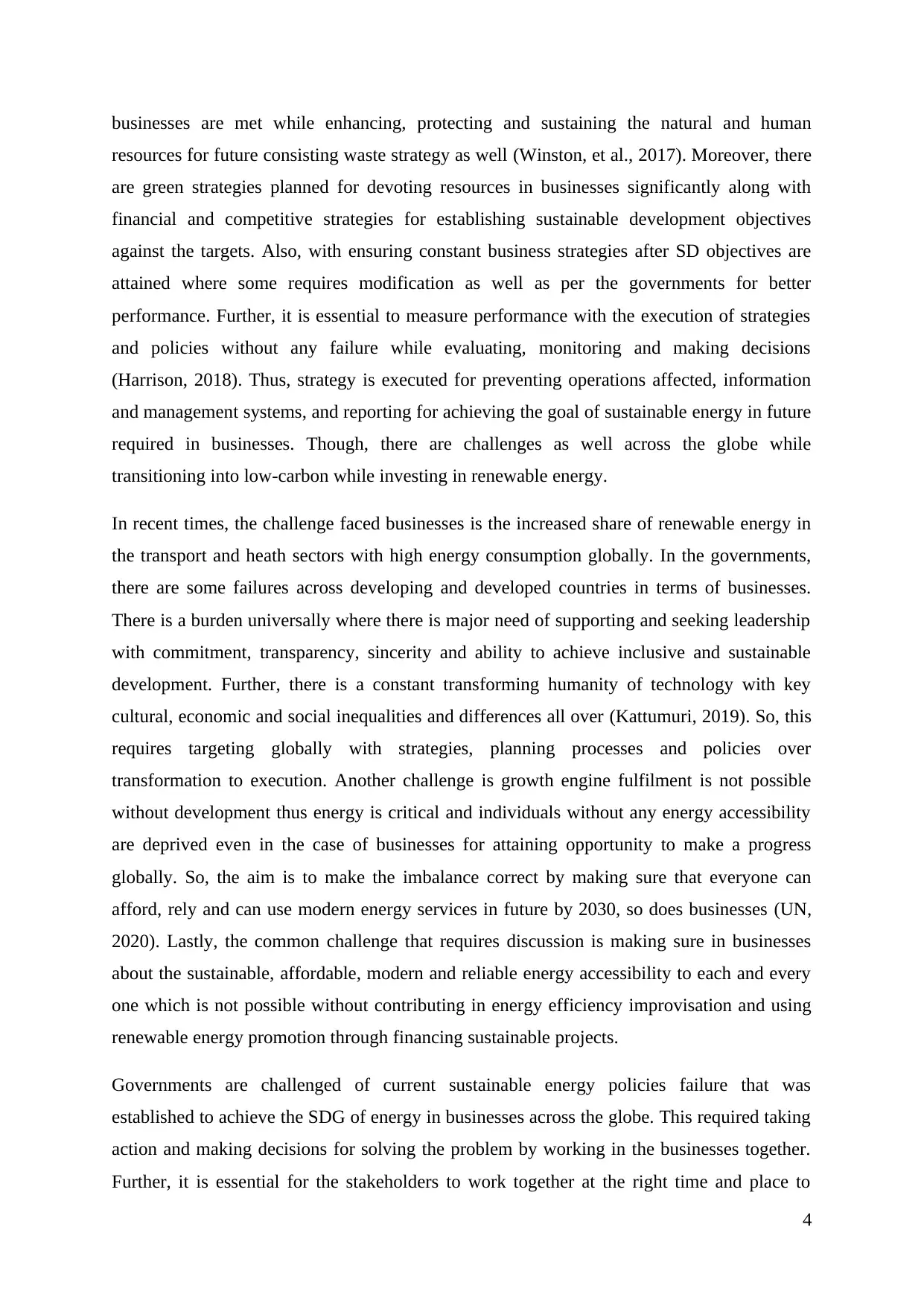
businesses are met while enhancing, protecting and sustaining the natural and human
resources for future consisting waste strategy as well (Winston, et al., 2017). Moreover, there
are green strategies planned for devoting resources in businesses significantly along with
financial and competitive strategies for establishing sustainable development objectives
against the targets. Also, with ensuring constant business strategies after SD objectives are
attained where some requires modification as well as per the governments for better
performance. Further, it is essential to measure performance with the execution of strategies
and policies without any failure while evaluating, monitoring and making decisions
(Harrison, 2018). Thus, strategy is executed for preventing operations affected, information
and management systems, and reporting for achieving the goal of sustainable energy in future
required in businesses. Though, there are challenges as well across the globe while
transitioning into low-carbon while investing in renewable energy.
In recent times, the challenge faced businesses is the increased share of renewable energy in
the transport and heath sectors with high energy consumption globally. In the governments,
there are some failures across developing and developed countries in terms of businesses.
There is a burden universally where there is major need of supporting and seeking leadership
with commitment, transparency, sincerity and ability to achieve inclusive and sustainable
development. Further, there is a constant transforming humanity of technology with key
cultural, economic and social inequalities and differences all over (Kattumuri, 2019). So, this
requires targeting globally with strategies, planning processes and policies over
transformation to execution. Another challenge is growth engine fulfilment is not possible
without development thus energy is critical and individuals without any energy accessibility
are deprived even in the case of businesses for attaining opportunity to make a progress
globally. So, the aim is to make the imbalance correct by making sure that everyone can
afford, rely and can use modern energy services in future by 2030, so does businesses (UN,
2020). Lastly, the common challenge that requires discussion is making sure in businesses
about the sustainable, affordable, modern and reliable energy accessibility to each and every
one which is not possible without contributing in energy efficiency improvisation and using
renewable energy promotion through financing sustainable projects.
Governments are challenged of current sustainable energy policies failure that was
established to achieve the SDG of energy in businesses across the globe. This required taking
action and making decisions for solving the problem by working in the businesses together.
Further, it is essential for the stakeholders to work together at the right time and place to
4
resources for future consisting waste strategy as well (Winston, et al., 2017). Moreover, there
are green strategies planned for devoting resources in businesses significantly along with
financial and competitive strategies for establishing sustainable development objectives
against the targets. Also, with ensuring constant business strategies after SD objectives are
attained where some requires modification as well as per the governments for better
performance. Further, it is essential to measure performance with the execution of strategies
and policies without any failure while evaluating, monitoring and making decisions
(Harrison, 2018). Thus, strategy is executed for preventing operations affected, information
and management systems, and reporting for achieving the goal of sustainable energy in future
required in businesses. Though, there are challenges as well across the globe while
transitioning into low-carbon while investing in renewable energy.
In recent times, the challenge faced businesses is the increased share of renewable energy in
the transport and heath sectors with high energy consumption globally. In the governments,
there are some failures across developing and developed countries in terms of businesses.
There is a burden universally where there is major need of supporting and seeking leadership
with commitment, transparency, sincerity and ability to achieve inclusive and sustainable
development. Further, there is a constant transforming humanity of technology with key
cultural, economic and social inequalities and differences all over (Kattumuri, 2019). So, this
requires targeting globally with strategies, planning processes and policies over
transformation to execution. Another challenge is growth engine fulfilment is not possible
without development thus energy is critical and individuals without any energy accessibility
are deprived even in the case of businesses for attaining opportunity to make a progress
globally. So, the aim is to make the imbalance correct by making sure that everyone can
afford, rely and can use modern energy services in future by 2030, so does businesses (UN,
2020). Lastly, the common challenge that requires discussion is making sure in businesses
about the sustainable, affordable, modern and reliable energy accessibility to each and every
one which is not possible without contributing in energy efficiency improvisation and using
renewable energy promotion through financing sustainable projects.
Governments are challenged of current sustainable energy policies failure that was
established to achieve the SDG of energy in businesses across the globe. This required taking
action and making decisions for solving the problem by working in the businesses together.
Further, it is essential for the stakeholders to work together at the right time and place to
4
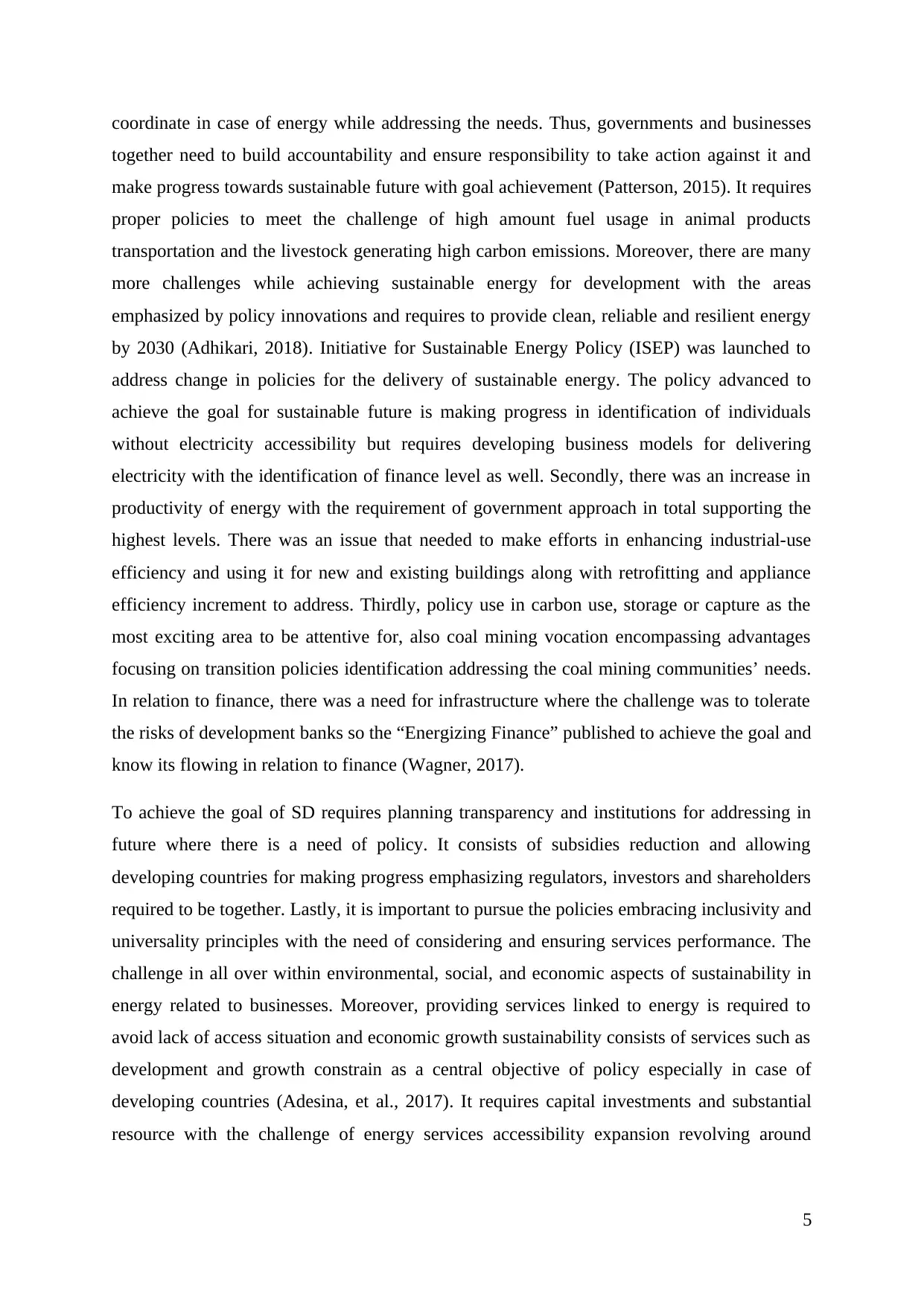
coordinate in case of energy while addressing the needs. Thus, governments and businesses
together need to build accountability and ensure responsibility to take action against it and
make progress towards sustainable future with goal achievement (Patterson, 2015). It requires
proper policies to meet the challenge of high amount fuel usage in animal products
transportation and the livestock generating high carbon emissions. Moreover, there are many
more challenges while achieving sustainable energy for development with the areas
emphasized by policy innovations and requires to provide clean, reliable and resilient energy
by 2030 (Adhikari, 2018). Initiative for Sustainable Energy Policy (ISEP) was launched to
address change in policies for the delivery of sustainable energy. The policy advanced to
achieve the goal for sustainable future is making progress in identification of individuals
without electricity accessibility but requires developing business models for delivering
electricity with the identification of finance level as well. Secondly, there was an increase in
productivity of energy with the requirement of government approach in total supporting the
highest levels. There was an issue that needed to make efforts in enhancing industrial-use
efficiency and using it for new and existing buildings along with retrofitting and appliance
efficiency increment to address. Thirdly, policy use in carbon use, storage or capture as the
most exciting area to be attentive for, also coal mining vocation encompassing advantages
focusing on transition policies identification addressing the coal mining communities’ needs.
In relation to finance, there was a need for infrastructure where the challenge was to tolerate
the risks of development banks so the “Energizing Finance” published to achieve the goal and
know its flowing in relation to finance (Wagner, 2017).
To achieve the goal of SD requires planning transparency and institutions for addressing in
future where there is a need of policy. It consists of subsidies reduction and allowing
developing countries for making progress emphasizing regulators, investors and shareholders
required to be together. Lastly, it is important to pursue the policies embracing inclusivity and
universality principles with the need of considering and ensuring services performance. The
challenge in all over within environmental, social, and economic aspects of sustainability in
energy related to businesses. Moreover, providing services linked to energy is required to
avoid lack of access situation and economic growth sustainability consists of services such as
development and growth constrain as a central objective of policy especially in case of
developing countries (Adesina, et al., 2017). It requires capital investments and substantial
resource with the challenge of energy services accessibility expansion revolving around
5
together need to build accountability and ensure responsibility to take action against it and
make progress towards sustainable future with goal achievement (Patterson, 2015). It requires
proper policies to meet the challenge of high amount fuel usage in animal products
transportation and the livestock generating high carbon emissions. Moreover, there are many
more challenges while achieving sustainable energy for development with the areas
emphasized by policy innovations and requires to provide clean, reliable and resilient energy
by 2030 (Adhikari, 2018). Initiative for Sustainable Energy Policy (ISEP) was launched to
address change in policies for the delivery of sustainable energy. The policy advanced to
achieve the goal for sustainable future is making progress in identification of individuals
without electricity accessibility but requires developing business models for delivering
electricity with the identification of finance level as well. Secondly, there was an increase in
productivity of energy with the requirement of government approach in total supporting the
highest levels. There was an issue that needed to make efforts in enhancing industrial-use
efficiency and using it for new and existing buildings along with retrofitting and appliance
efficiency increment to address. Thirdly, policy use in carbon use, storage or capture as the
most exciting area to be attentive for, also coal mining vocation encompassing advantages
focusing on transition policies identification addressing the coal mining communities’ needs.
In relation to finance, there was a need for infrastructure where the challenge was to tolerate
the risks of development banks so the “Energizing Finance” published to achieve the goal and
know its flowing in relation to finance (Wagner, 2017).
To achieve the goal of SD requires planning transparency and institutions for addressing in
future where there is a need of policy. It consists of subsidies reduction and allowing
developing countries for making progress emphasizing regulators, investors and shareholders
required to be together. Lastly, it is important to pursue the policies embracing inclusivity and
universality principles with the need of considering and ensuring services performance. The
challenge in all over within environmental, social, and economic aspects of sustainability in
energy related to businesses. Moreover, providing services linked to energy is required to
avoid lack of access situation and economic growth sustainability consists of services such as
development and growth constrain as a central objective of policy especially in case of
developing countries (Adesina, et al., 2017). It requires capital investments and substantial
resource with the challenge of energy services accessibility expansion revolving around
5
⊘ This is a preview!⊘
Do you want full access?
Subscribe today to unlock all pages.

Trusted by 1+ million students worldwide
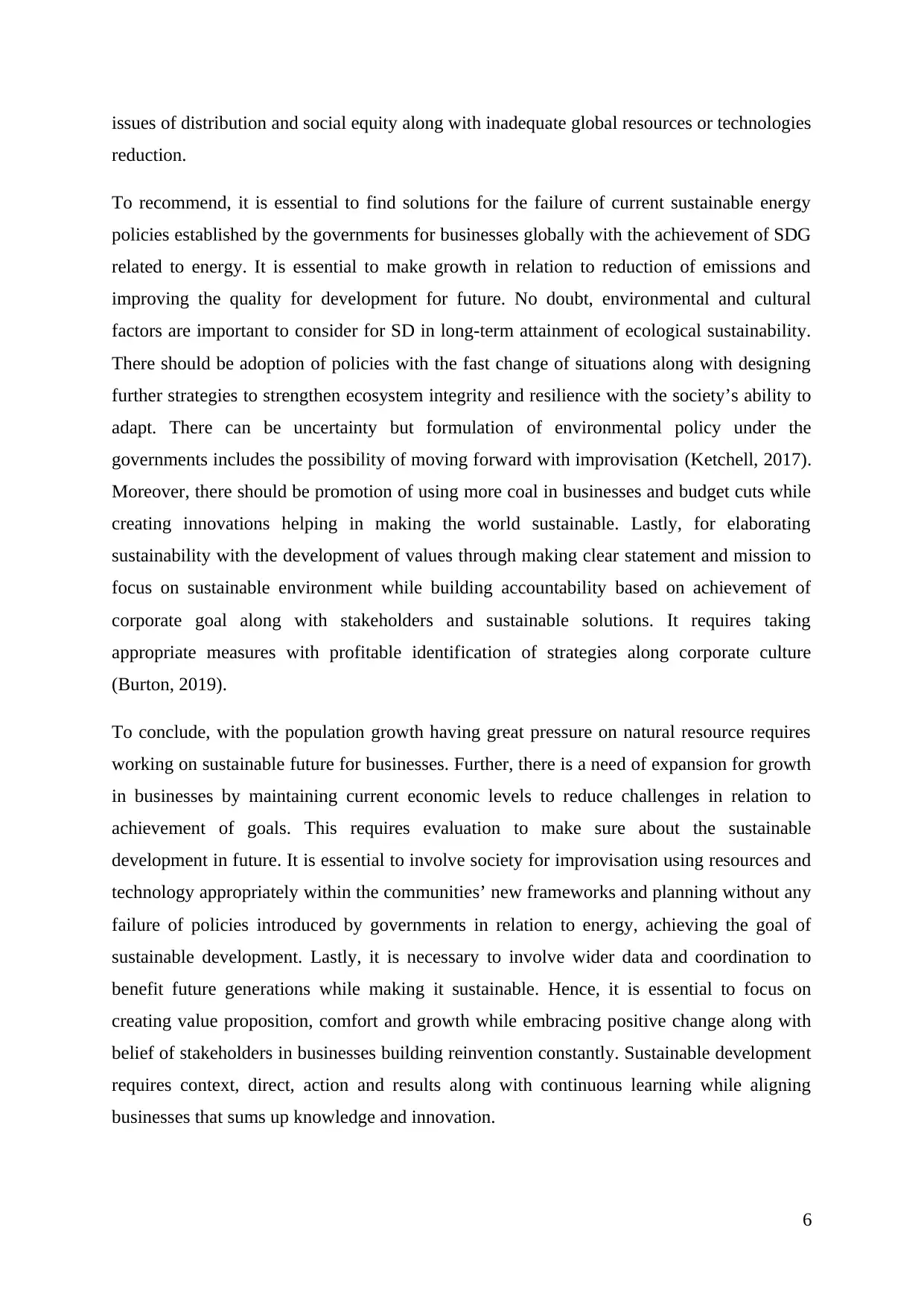
issues of distribution and social equity along with inadequate global resources or technologies
reduction.
To recommend, it is essential to find solutions for the failure of current sustainable energy
policies established by the governments for businesses globally with the achievement of SDG
related to energy. It is essential to make growth in relation to reduction of emissions and
improving the quality for development for future. No doubt, environmental and cultural
factors are important to consider for SD in long-term attainment of ecological sustainability.
There should be adoption of policies with the fast change of situations along with designing
further strategies to strengthen ecosystem integrity and resilience with the society’s ability to
adapt. There can be uncertainty but formulation of environmental policy under the
governments includes the possibility of moving forward with improvisation (Ketchell, 2017).
Moreover, there should be promotion of using more coal in businesses and budget cuts while
creating innovations helping in making the world sustainable. Lastly, for elaborating
sustainability with the development of values through making clear statement and mission to
focus on sustainable environment while building accountability based on achievement of
corporate goal along with stakeholders and sustainable solutions. It requires taking
appropriate measures with profitable identification of strategies along corporate culture
(Burton, 2019).
To conclude, with the population growth having great pressure on natural resource requires
working on sustainable future for businesses. Further, there is a need of expansion for growth
in businesses by maintaining current economic levels to reduce challenges in relation to
achievement of goals. This requires evaluation to make sure about the sustainable
development in future. It is essential to involve society for improvisation using resources and
technology appropriately within the communities’ new frameworks and planning without any
failure of policies introduced by governments in relation to energy, achieving the goal of
sustainable development. Lastly, it is necessary to involve wider data and coordination to
benefit future generations while making it sustainable. Hence, it is essential to focus on
creating value proposition, comfort and growth while embracing positive change along with
belief of stakeholders in businesses building reinvention constantly. Sustainable development
requires context, direct, action and results along with continuous learning while aligning
businesses that sums up knowledge and innovation.
6
reduction.
To recommend, it is essential to find solutions for the failure of current sustainable energy
policies established by the governments for businesses globally with the achievement of SDG
related to energy. It is essential to make growth in relation to reduction of emissions and
improving the quality for development for future. No doubt, environmental and cultural
factors are important to consider for SD in long-term attainment of ecological sustainability.
There should be adoption of policies with the fast change of situations along with designing
further strategies to strengthen ecosystem integrity and resilience with the society’s ability to
adapt. There can be uncertainty but formulation of environmental policy under the
governments includes the possibility of moving forward with improvisation (Ketchell, 2017).
Moreover, there should be promotion of using more coal in businesses and budget cuts while
creating innovations helping in making the world sustainable. Lastly, for elaborating
sustainability with the development of values through making clear statement and mission to
focus on sustainable environment while building accountability based on achievement of
corporate goal along with stakeholders and sustainable solutions. It requires taking
appropriate measures with profitable identification of strategies along corporate culture
(Burton, 2019).
To conclude, with the population growth having great pressure on natural resource requires
working on sustainable future for businesses. Further, there is a need of expansion for growth
in businesses by maintaining current economic levels to reduce challenges in relation to
achievement of goals. This requires evaluation to make sure about the sustainable
development in future. It is essential to involve society for improvisation using resources and
technology appropriately within the communities’ new frameworks and planning without any
failure of policies introduced by governments in relation to energy, achieving the goal of
sustainable development. Lastly, it is necessary to involve wider data and coordination to
benefit future generations while making it sustainable. Hence, it is essential to focus on
creating value proposition, comfort and growth while embracing positive change along with
belief of stakeholders in businesses building reinvention constantly. Sustainable development
requires context, direct, action and results along with continuous learning while aligning
businesses that sums up knowledge and innovation.
6
Paraphrase This Document
Need a fresh take? Get an instant paraphrase of this document with our AI Paraphraser
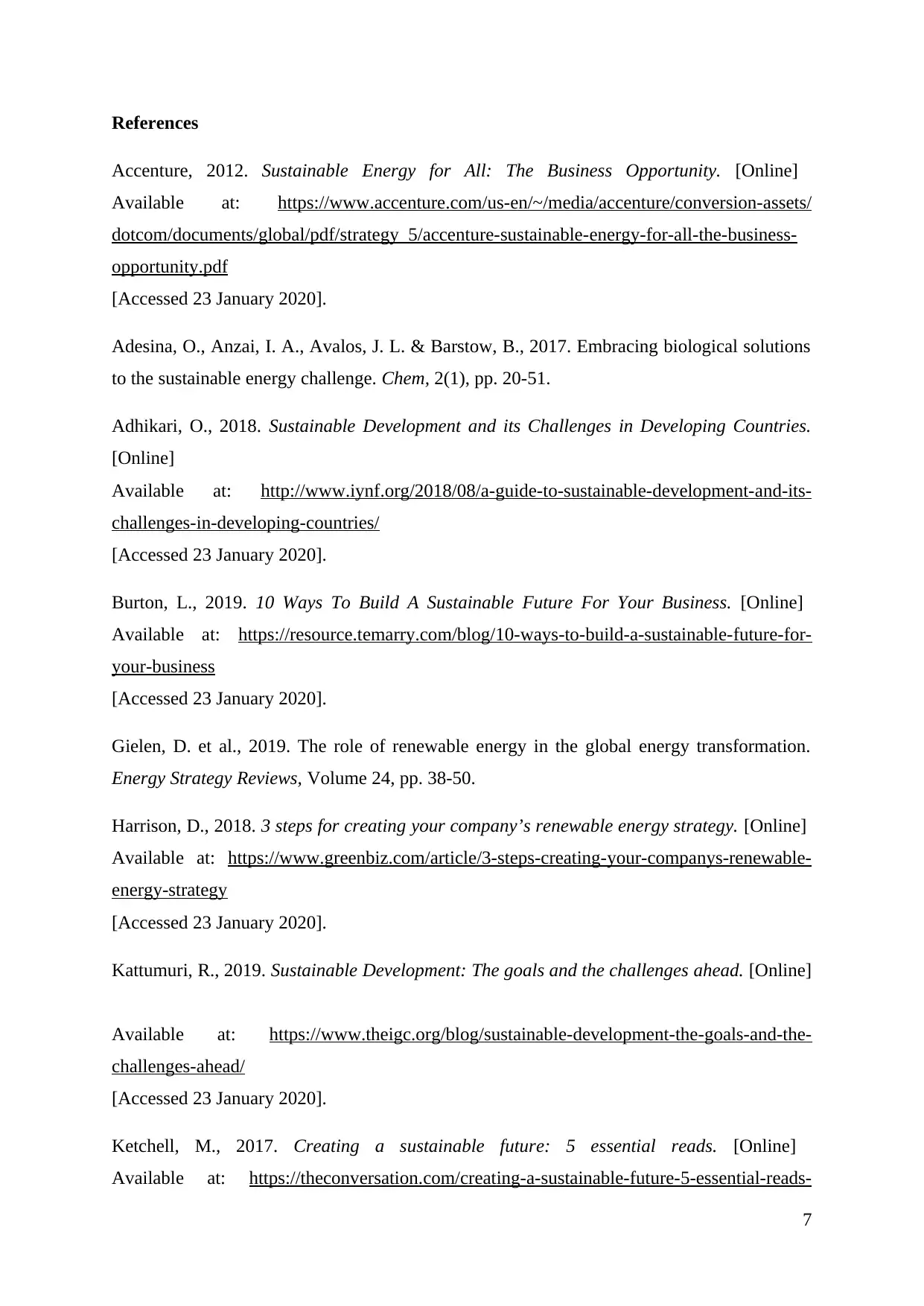
References
Accenture, 2012. Sustainable Energy for All: The Business Opportunity. [Online]
Available at: https://www.accenture.com/us-en/~/media/accenture/conversion-assets/
dotcom/documents/global/pdf/strategy_5/accenture-sustainable-energy-for-all-the-business-
opportunity.pdf
[Accessed 23 January 2020].
Adesina, O., Anzai, I. A., Avalos, J. L. & Barstow, B., 2017. Embracing biological solutions
to the sustainable energy challenge. Chem, 2(1), pp. 20-51.
Adhikari, O., 2018. Sustainable Development and its Challenges in Developing Countries.
[Online]
Available at: http://www.iynf.org/2018/08/a-guide-to-sustainable-development-and-its-
challenges-in-developing-countries/
[Accessed 23 January 2020].
Burton, L., 2019. 10 Ways To Build A Sustainable Future For Your Business. [Online]
Available at: https://resource.temarry.com/blog/10-ways-to-build-a-sustainable-future-for-
your-business
[Accessed 23 January 2020].
Gielen, D. et al., 2019. The role of renewable energy in the global energy transformation.
Energy Strategy Reviews, Volume 24, pp. 38-50.
Harrison, D., 2018. 3 steps for creating your company’s renewable energy strategy. [Online]
Available at: https://www.greenbiz.com/article/3-steps-creating-your-companys-renewable-
energy-strategy
[Accessed 23 January 2020].
Kattumuri, R., 2019. Sustainable Development: The goals and the challenges ahead. [Online]
Available at: https://www.theigc.org/blog/sustainable-development-the-goals-and-the-
challenges-ahead/
[Accessed 23 January 2020].
Ketchell, M., 2017. Creating a sustainable future: 5 essential reads. [Online]
Available at: https://theconversation.com/creating-a-sustainable-future-5-essential-reads-
7
Accenture, 2012. Sustainable Energy for All: The Business Opportunity. [Online]
Available at: https://www.accenture.com/us-en/~/media/accenture/conversion-assets/
dotcom/documents/global/pdf/strategy_5/accenture-sustainable-energy-for-all-the-business-
opportunity.pdf
[Accessed 23 January 2020].
Adesina, O., Anzai, I. A., Avalos, J. L. & Barstow, B., 2017. Embracing biological solutions
to the sustainable energy challenge. Chem, 2(1), pp. 20-51.
Adhikari, O., 2018. Sustainable Development and its Challenges in Developing Countries.
[Online]
Available at: http://www.iynf.org/2018/08/a-guide-to-sustainable-development-and-its-
challenges-in-developing-countries/
[Accessed 23 January 2020].
Burton, L., 2019. 10 Ways To Build A Sustainable Future For Your Business. [Online]
Available at: https://resource.temarry.com/blog/10-ways-to-build-a-sustainable-future-for-
your-business
[Accessed 23 January 2020].
Gielen, D. et al., 2019. The role of renewable energy in the global energy transformation.
Energy Strategy Reviews, Volume 24, pp. 38-50.
Harrison, D., 2018. 3 steps for creating your company’s renewable energy strategy. [Online]
Available at: https://www.greenbiz.com/article/3-steps-creating-your-companys-renewable-
energy-strategy
[Accessed 23 January 2020].
Kattumuri, R., 2019. Sustainable Development: The goals and the challenges ahead. [Online]
Available at: https://www.theigc.org/blog/sustainable-development-the-goals-and-the-
challenges-ahead/
[Accessed 23 January 2020].
Ketchell, M., 2017. Creating a sustainable future: 5 essential reads. [Online]
Available at: https://theconversation.com/creating-a-sustainable-future-5-essential-reads-
7
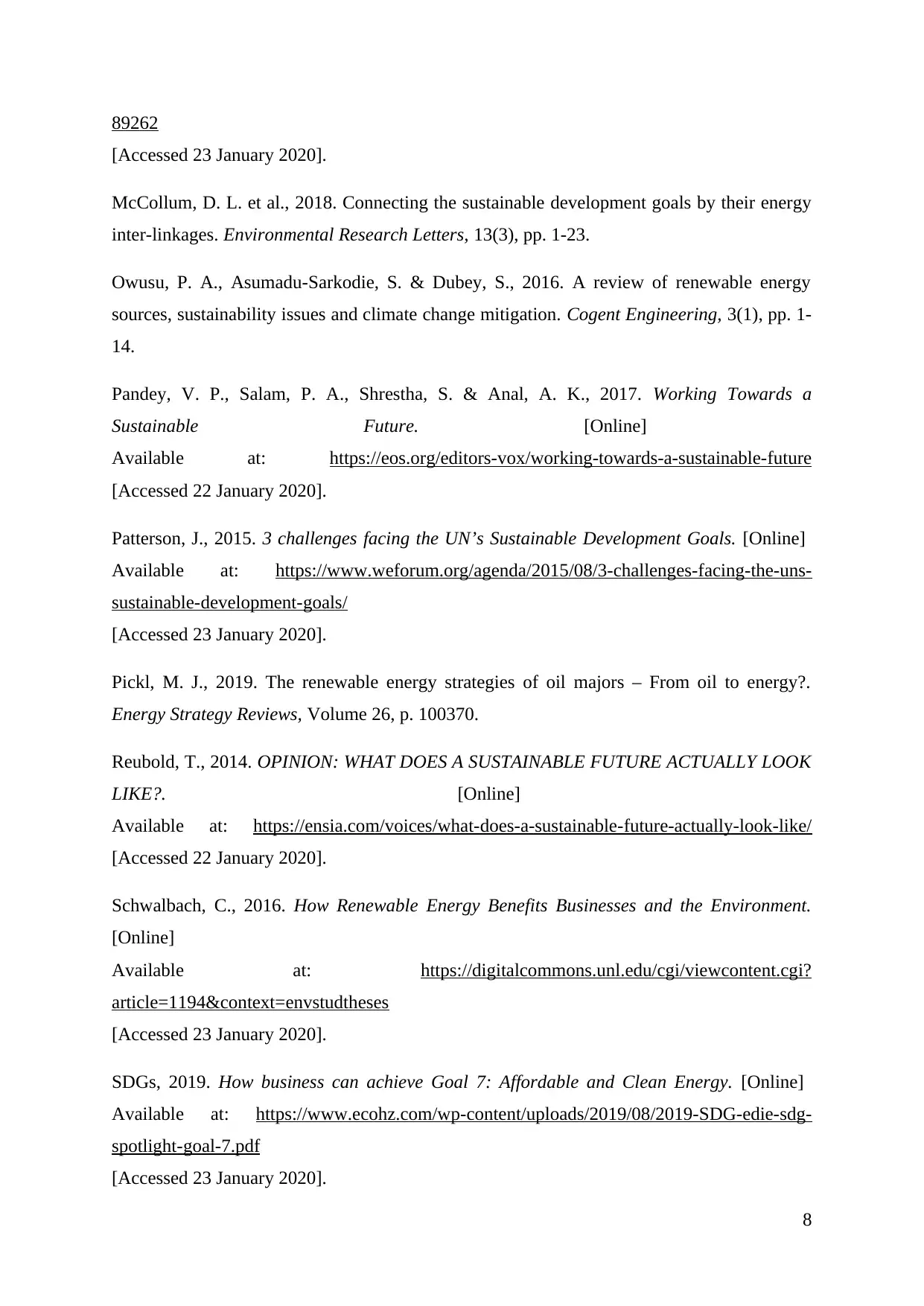
89262
[Accessed 23 January 2020].
McCollum, D. L. et al., 2018. Connecting the sustainable development goals by their energy
inter-linkages. Environmental Research Letters, 13(3), pp. 1-23.
Owusu, P. A., Asumadu-Sarkodie, S. & Dubey, S., 2016. A review of renewable energy
sources, sustainability issues and climate change mitigation. Cogent Engineering, 3(1), pp. 1-
14.
Pandey, V. P., Salam, P. A., Shrestha, S. & Anal, A. K., 2017. Working Towards a
Sustainable Future. [Online]
Available at: https://eos.org/editors-vox/working-towards-a-sustainable-future
[Accessed 22 January 2020].
Patterson, J., 2015. 3 challenges facing the UN’s Sustainable Development Goals. [Online]
Available at: https://www.weforum.org/agenda/2015/08/3-challenges-facing-the-uns-
sustainable-development-goals/
[Accessed 23 January 2020].
Pickl, M. J., 2019. The renewable energy strategies of oil majors – From oil to energy?.
Energy Strategy Reviews, Volume 26, p. 100370.
Reubold, T., 2014. OPINION: WHAT DOES A SUSTAINABLE FUTURE ACTUALLY LOOK
LIKE?. [Online]
Available at: https://ensia.com/voices/what-does-a-sustainable-future-actually-look-like/
[Accessed 22 January 2020].
Schwalbach, C., 2016. How Renewable Energy Benefits Businesses and the Environment.
[Online]
Available at: https://digitalcommons.unl.edu/cgi/viewcontent.cgi?
article=1194&context=envstudtheses
[Accessed 23 January 2020].
SDGs, 2019. How business can achieve Goal 7: Affordable and Clean Energy. [Online]
Available at: https://www.ecohz.com/wp-content/uploads/2019/08/2019-SDG-edie-sdg-
spotlight-goal-7.pdf
[Accessed 23 January 2020].
8
[Accessed 23 January 2020].
McCollum, D. L. et al., 2018. Connecting the sustainable development goals by their energy
inter-linkages. Environmental Research Letters, 13(3), pp. 1-23.
Owusu, P. A., Asumadu-Sarkodie, S. & Dubey, S., 2016. A review of renewable energy
sources, sustainability issues and climate change mitigation. Cogent Engineering, 3(1), pp. 1-
14.
Pandey, V. P., Salam, P. A., Shrestha, S. & Anal, A. K., 2017. Working Towards a
Sustainable Future. [Online]
Available at: https://eos.org/editors-vox/working-towards-a-sustainable-future
[Accessed 22 January 2020].
Patterson, J., 2015. 3 challenges facing the UN’s Sustainable Development Goals. [Online]
Available at: https://www.weforum.org/agenda/2015/08/3-challenges-facing-the-uns-
sustainable-development-goals/
[Accessed 23 January 2020].
Pickl, M. J., 2019. The renewable energy strategies of oil majors – From oil to energy?.
Energy Strategy Reviews, Volume 26, p. 100370.
Reubold, T., 2014. OPINION: WHAT DOES A SUSTAINABLE FUTURE ACTUALLY LOOK
LIKE?. [Online]
Available at: https://ensia.com/voices/what-does-a-sustainable-future-actually-look-like/
[Accessed 22 January 2020].
Schwalbach, C., 2016. How Renewable Energy Benefits Businesses and the Environment.
[Online]
Available at: https://digitalcommons.unl.edu/cgi/viewcontent.cgi?
article=1194&context=envstudtheses
[Accessed 23 January 2020].
SDGs, 2019. How business can achieve Goal 7: Affordable and Clean Energy. [Online]
Available at: https://www.ecohz.com/wp-content/uploads/2019/08/2019-SDG-edie-sdg-
spotlight-goal-7.pdf
[Accessed 23 January 2020].
8
⊘ This is a preview!⊘
Do you want full access?
Subscribe today to unlock all pages.

Trusted by 1+ million students worldwide
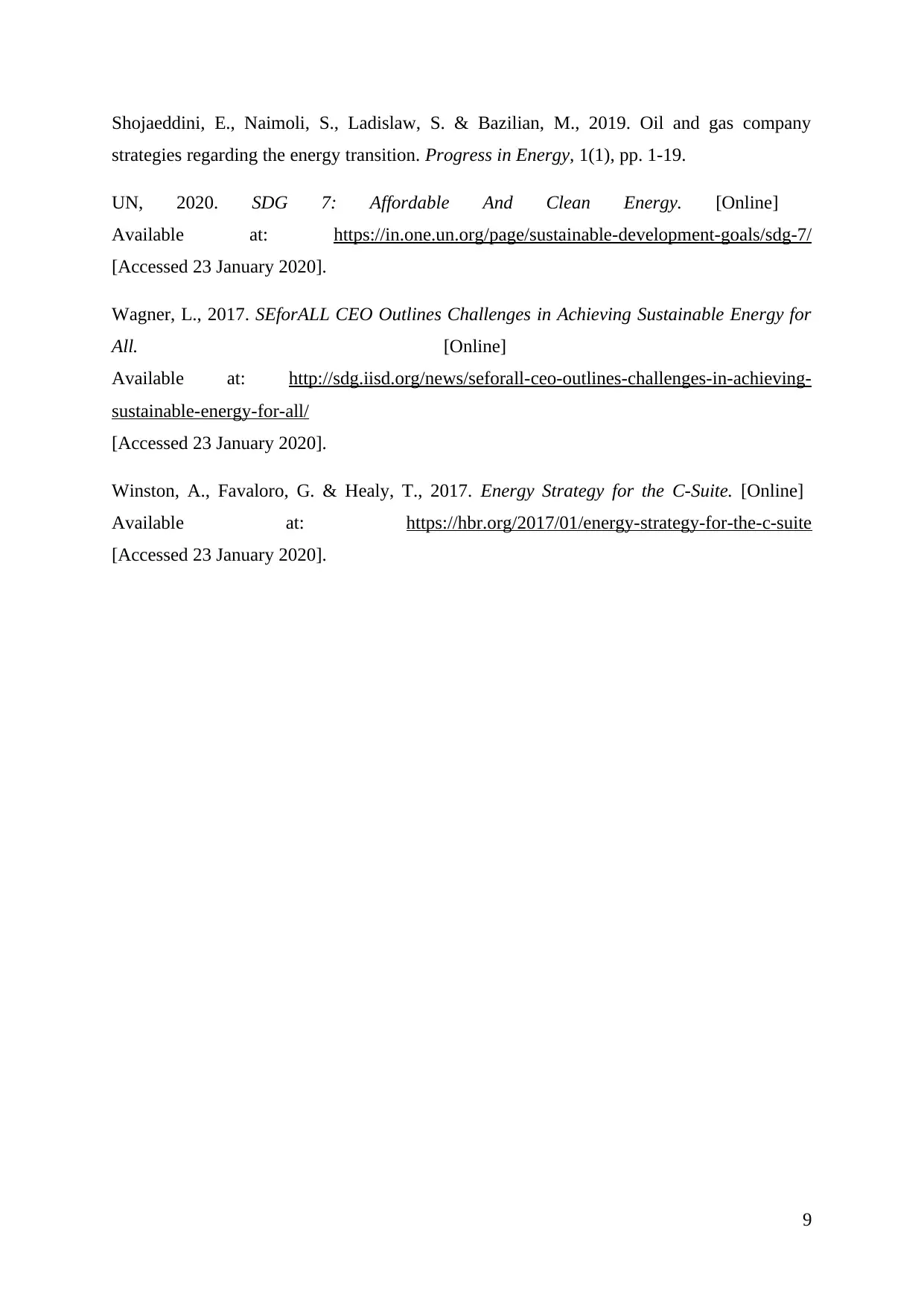
Shojaeddini, E., Naimoli, S., Ladislaw, S. & Bazilian, M., 2019. Oil and gas company
strategies regarding the energy transition. Progress in Energy, 1(1), pp. 1-19.
UN, 2020. SDG 7: Affordable And Clean Energy. [Online]
Available at: https://in.one.un.org/page/sustainable-development-goals/sdg-7/
[Accessed 23 January 2020].
Wagner, L., 2017. SEforALL CEO Outlines Challenges in Achieving Sustainable Energy for
All. [Online]
Available at: http://sdg.iisd.org/news/seforall-ceo-outlines-challenges-in-achieving-
sustainable-energy-for-all/
[Accessed 23 January 2020].
Winston, A., Favaloro, G. & Healy, T., 2017. Energy Strategy for the C-Suite. [Online]
Available at: https://hbr.org/2017/01/energy-strategy-for-the-c-suite
[Accessed 23 January 2020].
9
strategies regarding the energy transition. Progress in Energy, 1(1), pp. 1-19.
UN, 2020. SDG 7: Affordable And Clean Energy. [Online]
Available at: https://in.one.un.org/page/sustainable-development-goals/sdg-7/
[Accessed 23 January 2020].
Wagner, L., 2017. SEforALL CEO Outlines Challenges in Achieving Sustainable Energy for
All. [Online]
Available at: http://sdg.iisd.org/news/seforall-ceo-outlines-challenges-in-achieving-
sustainable-energy-for-all/
[Accessed 23 January 2020].
Winston, A., Favaloro, G. & Healy, T., 2017. Energy Strategy for the C-Suite. [Online]
Available at: https://hbr.org/2017/01/energy-strategy-for-the-c-suite
[Accessed 23 January 2020].
9
1 out of 10
Related Documents
Your All-in-One AI-Powered Toolkit for Academic Success.
+13062052269
info@desklib.com
Available 24*7 on WhatsApp / Email
![[object Object]](/_next/static/media/star-bottom.7253800d.svg)
Unlock your academic potential
Copyright © 2020–2025 A2Z Services. All Rights Reserved. Developed and managed by ZUCOL.




